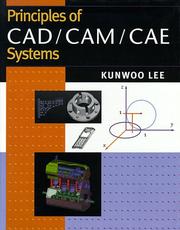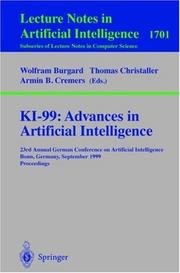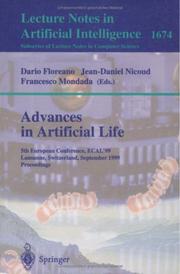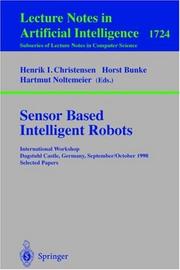| Listing 1 - 10 of 10 |
Sort by
|
Periodical
Year: 1999 Publisher: Boynton Beach, Fla. : Worldwide Videotex
Abstract | Keywords | Export | Availability | Bookmark
 Loading...
Loading...Choose an application
- Reference Manager
- EndNote
- RefWorks (Direct export to RefWorks)
Periodical
Year: 1999 Publisher: Boynton Beach, Fla. : Worldwide Videotex
Abstract | Keywords | Export | Availability | Bookmark
 Loading...
Loading...Choose an application
- Reference Manager
- EndNote
- RefWorks (Direct export to RefWorks)
Periodical
Year: 1999 Publisher: Boynton Beach, Fla. : Worldwide Videotex
Abstract | Keywords | Export | Availability | Bookmark
 Loading...
Loading...Choose an application
- Reference Manager
- EndNote
- RefWorks (Direct export to RefWorks)

ISBN: 0201380366 Year: 1999 Publisher: Reading, MA Harlow Menlo Park, CA : Addison-Wesley,
Abstract | Keywords | Export | Availability | Bookmark
 Loading...
Loading...Choose an application
- Reference Manager
- EndNote
- RefWorks (Direct export to RefWorks)

ISBN: 0792386574 Year: 1999 Volume: SECS 525 Publisher: Boston : Kluwer Academic,
Abstract | Keywords | Export | Availability | Bookmark
 Loading...
Loading...Choose an application
- Reference Manager
- EndNote
- RefWorks (Direct export to RefWorks)
CAD/CAM systems. --- Rapid prototyping. --- Electromechanical devices --- CFAO, Systèmes de --- Prototypage rapide --- Dispositifs électromécaniques

ISBN: 3540482385 3540664955 Year: 1999 Publisher: Berlin, Germany : Springer,
Abstract | Keywords | Export | Availability | Bookmark
 Loading...
Loading...Choose an application
- Reference Manager
- EndNote
- RefWorks (Direct export to RefWorks)
For many years, Arti?cial Intelligence technology has served in a great variety of successful applications. AI researchand researchershave contributed much to the vision of the so-called Information Society. As early as the 1980s, some of us imagined distributed knowledge bases containing the explicable knowledge of a company or any other organization. Today, such systems are becoming reality. In the process, other technologies have had to be developed and AI-technology has blended with them, and companies are now sensitive to this topic. TheInternetandWWWhaveprovidedtheglobalinfrastructure,whileatthe same time companies have become global in nearly every aspect of enterprise. This process has just started, a little experience has been gained, and therefore it is tempting to re?ect and try to forecast, what the next steps may be. This has given us one of the two main topics of the 23rd Annual German Conference on Arti?cial Intelligence (KI-99)held at the University of Bonn: The Knowledge Society. Two of our invited speakers, Helmut Willke, Bielefeld, and Hans-Peter Kriegel, Munich, dwell on di?erent aspects with di?erent perspectives. Helmut Willke deals with the concept of virtual organizations, while Hans-Peter Kriegel applies data mining concepts to pattern recognitiontasks.The three application forums are also part of the Knowledge Society topic: “IT-based innovation for environment and development”, “Knowledge management in enterprises”, and “Knowledgemanagementinvillageandcityplanningoftheinformationsociety”.
Artificial intelligence --- Computer Science --- Engineering & Applied Sciences --- Computer science. --- Artificial intelligence. --- Image processing. --- Pattern recognition. --- Robotics. --- Automation. --- Computer Science. --- Artificial Intelligence (incl. Robotics). --- Robotics and Automation. --- Image Processing and Computer Vision. --- Pattern Recognition. --- Computer vision. --- Optical pattern recognition. --- Artificial Intelligence. --- Optical data processing --- Pattern perception --- Perceptrons --- Visual discrimination --- Machine vision --- Vision, Computer --- Image processing --- Pattern recognition systems --- AI (Artificial intelligence) --- Artificial thinking --- Electronic brains --- Intellectronics --- Intelligence, Artificial --- Intelligent machines --- Machine intelligence --- Thinking, Artificial --- Bionics --- Cognitive science --- Digital computer simulation --- Electronic data processing --- Logic machines --- Machine theory --- Self-organizing systems --- Simulation methods --- Fifth generation computers --- Neural computers --- Optical data processing. --- Design perception --- Pattern recognition --- Form perception --- Perception --- Figure-ground perception --- Optical computing --- Visual data processing --- Integrated optics --- Photonics --- Computers --- Automatic factories --- Automatic production --- Computer control --- Engineering cybernetics --- Factories --- Industrial engineering --- Mechanization --- Assembly-line methods --- Automatic control --- Automatic machinery --- CAD/CAM systems --- Robotics --- Automation --- Optical equipment

ISBN: 0792377338 1461369959 1461544319 Year: 1999 Publisher: Boston (Mass.) : Kluwer academic,
Abstract | Keywords | Export | Availability | Bookmark
 Loading...
Loading...Choose an application
- Reference Manager
- EndNote
- RefWorks (Direct export to RefWorks)
One of the fundamental requirements for the success of a robot task is the capability to handle interaction between manipulator and environment. The quantity that describes the state of interaction more effectively is the contact force at the manipulator's end effector. High values of contact force are generally undesirable since they may stress both the manipulator and the manipulated object; hence the need to seek for effective force control strategies. The book provides a theoretical and experimental treatment of robot interaction control. In the framework of model-based operational space control, stiffness control and impedance control are presented as the basic strategies for indirect force control; a key feature is the coverage of six-degree-of-freedom interaction tasks and manipulator kinematic redundancy. Then, direct force control strategies are presented which are obtained from motion control schemes suitably modified by the closure of an outer force regulation feedback loop. Finally, advanced force and position control strategies are presented which include passivity-based, adaptive and output feedback control schemes. Remarkably, all control schemes are experimentally tested on a setup consisting of a seven-joint industrial robot with open control architecture and force/torque sensor. The topic of robot force control is not treated in depth in robotics textbooks, in spite of its crucial importance for practical manipulation tasks. In the few books addressing this topic, the material is often limited to single-degree-of-freedom tasks. On the other hand, several results are available in the robotics literature but no dedicated monograph exists. The book is thus aimed at filling this gap by providing a theoretical and experimental treatment of robot force control.
681.3*I29 --- Robotics: manipulators; propelling mechanisms; sensors (Artificial intelli- gence) --- Robots --- Control systems. --- 681.3*I29 Robotics: manipulators; propelling mechanisms; sensors (Artificial intelli- gence) --- Robot control --- Robotics --- Control systems --- Robotics. --- Automation. --- Control engineering. --- Mechatronics. --- Mechanical engineering. --- Artificial intelligence. --- Robotics and Automation. --- Control, Robotics, Mechatronics. --- Mechanical Engineering. --- Artificial Intelligence. --- AI (Artificial intelligence) --- Artificial thinking --- Electronic brains --- Intellectronics --- Intelligence, Artificial --- Intelligent machines --- Machine intelligence --- Thinking, Artificial --- Bionics --- Cognitive science --- Digital computer simulation --- Electronic data processing --- Logic machines --- Machine theory --- Self-organizing systems --- Simulation methods --- Fifth generation computers --- Neural computers --- Engineering, Mechanical --- Engineering --- Machinery --- Steam engineering --- Mechanical engineering --- Microelectronics --- Microelectromechanical systems --- Control engineering --- Control equipment --- Control theory --- Engineering instruments --- Automation --- Programmable controllers --- Automatic factories --- Automatic production --- Computer control --- Engineering cybernetics --- Factories --- Industrial engineering --- Mechanization --- Assembly-line methods --- Automatic control --- Automatic machinery --- CAD/CAM systems

ISBN: 3540664521 3540483047 9783540664529 Year: 1999 Volume: 1674 Publisher: Berlin: Springer,
Abstract | Keywords | Export | Availability | Bookmark
 Loading...
Loading...Choose an application
- Reference Manager
- EndNote
- RefWorks (Direct export to RefWorks)
No matter what your perspective is, what your goals are, or how experienced you are, Artificial Life research is always a learning experience. The variety of phe nomena that the people who gathered in Lausanne reported and discussed for the fifth time since 1991 at the European Conference on Artificial Life (ECAL) has not been programmed, crafted, or assembled by analytic design. It has evolved, emerged, or appeared spontaneously from a process of artificial evolution, se- organisation, or development. Artificial Life is a field where biological and artificial sciences meet and blend together, where the dynamics of biological life are reproduced in the memory of computers, where machines evolve, behave, and communicate like living organ isms, where complex life-like entities are synthesised from electronic chromo somes and artificial chemistries. The impact of Artificial Life in science, phi losophy, and technology is tremendous. Over the years the synthetic approach has established itself as a powerful method for investigating several complex phenomena of life. From a philosophical standpoint, the notion of life and of in telligence is continuously reformulated in relation to the dynamics of the system under observation and to the embedding environment, no longer a privilege of carbon-based entities with brains and eyes. At the same time, the possibility of engineering machines and software with life-like properties such as evolvability, self-repair, and self-maintainance is gradually becoming reality, bringing new perspectives in engineering and applications.
Biological systems --- Robotics --- Artificial intelligence --- Computer simulation --- Simulation methods --- Computer science. --- Computers. --- Artificial intelligence. --- Bioinformatics. --- Computational biology. --- Robotics. --- Automation. --- Computer Science. --- Artificial Intelligence (incl. Robotics). --- Robotics and Automation. --- Computer Appl. in Life Sciences. --- Computation by Abstract Devices. --- Biology --- Artificial Intelligence. --- Data processing. --- Bioinformatics . --- Computational biology . --- AI (Artificial intelligence) --- Artificial thinking --- Electronic brains --- Intellectronics --- Intelligence, Artificial --- Intelligent machines --- Machine intelligence --- Thinking, Artificial --- Bionics --- Cognitive science --- Digital computer simulation --- Electronic data processing --- Logic machines --- Machine theory --- Self-organizing systems --- Fifth generation computers --- Neural computers --- Automatic computers --- Automatic data processors --- Computer hardware --- Computing machines (Computers) --- Electronic calculating-machines --- Electronic computers --- Hardware, Computer --- Computer systems --- Cybernetics --- Calculators --- Cyberspace --- Bioinformatics --- Bio-informatics --- Biological informatics --- Information science --- Computational biology --- Systems biology --- Automatic factories --- Automatic production --- Computer control --- Engineering cybernetics --- Factories --- Industrial engineering --- Mechanization --- Assembly-line methods --- Automatic control --- Automatic machinery --- CAD/CAM systems --- Automation --- Data processing --- Biological systems - Computer simulation - Congresses --- Biological systems - Simulation methods - Congresses --- Robotics - Congresses --- Artificial intelligence - Congresses

ISBN: 3540669337 3540466193 Year: 1999 Publisher: New York, NY ; Berlin : Springer-Verlag,
Abstract | Keywords | Export | Availability | Bookmark
 Loading...
Loading...Choose an application
- Reference Manager
- EndNote
- RefWorks (Direct export to RefWorks)
Robotics --- Intelligent control systems --- Mechanical Engineering - General --- Mechanical Engineering --- Engineering & Applied Sciences --- Robotics. --- Intelligent control systems. --- Intelligent control --- Intelligent controllers --- Computer science. --- Artificial intelligence. --- Computer simulation. --- Computer graphics. --- Image processing. --- Control engineering. --- Mechatronics. --- Automation. --- Computer Science. --- Artificial Intelligence (incl. Robotics). --- Robotics and Automation. --- Image Processing and Computer Vision. --- Simulation and Modeling. --- Computer Graphics. --- Control, Robotics, Mechatronics. --- Automatic control --- Automation --- Machine theory --- Computer vision. --- Artificial Intelligence. --- Automatic drafting --- Graphic data processing --- Graphics, Computer --- Computer art --- Graphic arts --- Electronic data processing --- Engineering graphics --- Image processing --- Computer modeling --- Computer models --- Modeling, Computer --- Models, Computer --- Simulation, Computer --- Electromechanical analogies --- Mathematical models --- Simulation methods --- Model-integrated computing --- Machine vision --- Vision, Computer --- Artificial intelligence --- Pattern recognition systems --- AI (Artificial intelligence) --- Artificial thinking --- Electronic brains --- Intellectronics --- Intelligence, Artificial --- Intelligent machines --- Machine intelligence --- Thinking, Artificial --- Bionics --- Cognitive science --- Digital computer simulation --- Logic machines --- Self-organizing systems --- Fifth generation computers --- Neural computers --- Digital techniques --- Optical data processing. --- Mechanical engineering --- Microelectronics --- Microelectromechanical systems --- Control engineering --- Control equipment --- Control theory --- Engineering instruments --- Programmable controllers --- Optical computing --- Visual data processing --- Integrated optics --- Photonics --- Computers --- Automatic factories --- Automatic production --- Computer control --- Engineering cybernetics --- Factories --- Industrial engineering --- Mechanization --- Assembly-line methods --- Automatic machinery --- CAD/CAM systems --- Optical equipment --- Social aspects. --- Data processing.
Book
ISBN: 3540484221 Year: 1999 Publisher: Berlin : Springer Verlag,
Abstract | Keywords | Export | Availability | Bookmark
 Loading...
Loading...Choose an application
- Reference Manager
- EndNote
- RefWorks (Direct export to RefWorks)
RoboCup is an international initiative devoted to advancing the state of the art in artificial intelligence and robotics. The aims of the project and potential research directions are numerous. The ultimate, long-range goal is to build a team of robot soccer players that can beat a human World Cup champion team. This book is the second official archival publication devoted to RoboCup. It documents the achievements presented at the Second International Workshop on RoboCup held in Paris, France, in July 1998. The book opens with an overview section, provides research papers on selected technical topics, and presents technical and strategic descriptions of the work of participating teams. Of interest far beyond the rapidly growing RoboCup community, this book is also indispensable reading for R&D professionals interested in multi-agent systems, distributed artificial intelligence, and intelligent robotics.
Robotics --- Artificial intelligence --- Soccer --- Computer simulation --- Artificial intelligence. --- Computer Communication Networks. --- Software engineering. --- Computer vision. --- Computer simulation. --- Artificial Intelligence. --- Robotics and Automation. --- Software Engineering. --- Image Processing and Computer Vision. --- Simulation and Modeling. --- Computer modeling --- Computer models --- Modeling, Computer --- Models, Computer --- Simulation, Computer --- Electromechanical analogies --- Mathematical models --- Simulation methods --- Model-integrated computing --- Machine vision --- Vision, Computer --- Image processing --- Pattern recognition systems --- Computer software engineering --- Engineering --- AI (Artificial intelligence) --- Artificial thinking --- Electronic brains --- Intellectronics --- Intelligence, Artificial --- Intelligent machines --- Machine intelligence --- Thinking, Artificial --- Bionics --- Cognitive science --- Digital computer simulation --- Electronic data processing --- Logic machines --- Machine theory --- Self-organizing systems --- Fifth generation computers --- Neural computers --- Robotics. --- Automation. --- Computer communication systems. --- Optical data processing. --- Optical computing --- Visual data processing --- Integrated optics --- Photonics --- Computers --- Communication systems, Computer --- Computer communication systems --- Data networks, Computer --- ECNs (Electronic communication networks) --- Electronic communication networks --- Networks, Computer --- Teleprocessing networks --- Data transmission systems --- Digital communications --- Electronic systems --- Information networks --- Telecommunication --- Cyberinfrastructure --- Network computers --- Automatic factories --- Automatic production --- Computer control --- Engineering cybernetics --- Factories --- Industrial engineering --- Mechanization --- Assembly-line methods --- Automatic control --- Automatic machinery --- CAD/CAM systems --- Automation --- Optical equipment --- Distributed processing
| Listing 1 - 10 of 10 |
Sort by
|

 Search
Search Feedback
Feedback About UniCat
About UniCat  Help
Help News
News